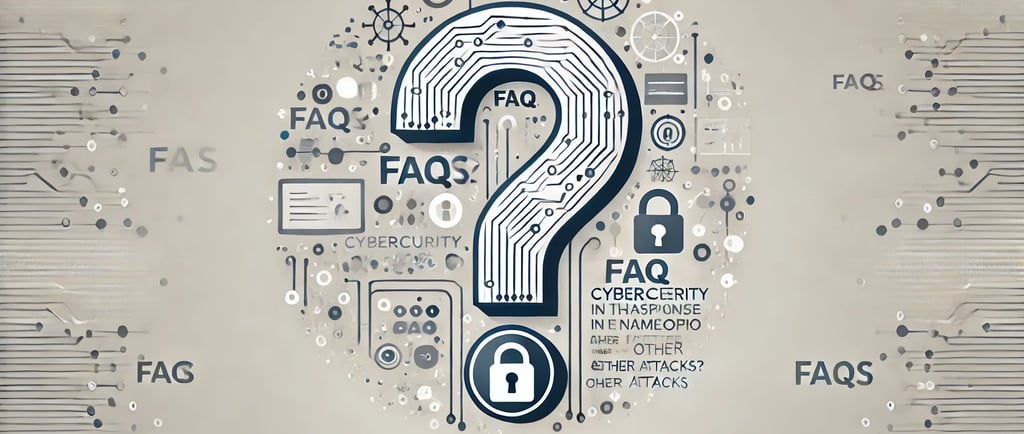FAQs on the Impact of the Telecom and Recent Cyberattacks
Explore how the recent cyberattacks impact businesses that were not directly targeted, understand how stolen data is typically exploited, and learn how to safeguard individuals and organisations effectively.
12/19/20243 min read


For Businesses
1. Why should businesses in Namibia care about the Telecom Namibia hack?
The Telecom Namibia breach exposed data of over 600,000 people, putting other businesses' customer profiles and operations at risk, even without a direct breach.
For example:
Customer Exploitation: Cybercriminals can use leaked data to impersonate your customers, make fraudulent refund requests, or gain unauthorised access to their accounts.
Operational Disruption: Hackers can use leaked data to launch targeted phishing attacks on your employees or systems.
Eroded Trust: Breaches reduce overall confidence in digital platforms, impacting sales, efficiency and long-term growth for all businesses.
2. How does the Telecom hack increase risks for Namibian SMEs?
50% of cyberattacks target SMEs (Cybersecurity Ventures 2023), as they often lack the resources to implement robust cybersecurity measures.
A breach like the Telecom hack may provide criminals with enough data to craft highly targeted attacks against other businesses.
Many SMEs may not survive a major attack—globally, 60% of small businesses shut down within six months of a cyberattack.
Unfortunately, only 44% of management boards recognise cyber threats as a significant concern (Deloitte Namibia, 2020). However, Cybercrime ranks as the 4th most significant risk for businesses in Namibia (Allianz Risk Barometer 2023).
3. Why is Namibia now a bigger target for cyberattacks?
The recent Telecom breach has placed Namibia on the radar of global hacker groups, marking the country as an easy target. We see this with the additional attacks that have happened in the last few days. Cybercriminals often follow patterns—when they identify weaknesses, they exploit them repeatedly.
4. What are the typical impacts of a cyberattack on a business?
Financial Losses: Cyber breaches are very costly for businesses. Recovery often involves flying in experts from abroad to restore IT systems, which can take weeks.
Reputational Damage: Such incidents harm trust in companies and can have long-term effects, such as the refusal to use the company’s online platforms.
Service Disruptions: For example, a ransomware attack on a tourism company could halt ongoing tours and block new bookings for weeks. A retail store may need to return to recording sales on paper.
5. What steps can businesses and individuals take to improve cybersecurity?
95% of cyberattacks involve human error, such as clicking on malicious links or falling for phishing scams (IBM Security Report, 2023). This is generally the easiest way for hackers to get into computer systems.
Invest in awareness training and phishing simulations to help employees identify and respond to threats. In Namibia, 20–30% of phishing emails are fallen for (Meinert Cybersecurity internal findings).
Conduct regular vulnerability assessments to identify and address system weaknesses.
Maintain secure backups and ensure they are regularly updated to protect against data loss.
Upgrade IT infrastructure to stay ahead of emerging threats.
In the EU and US, businesses spend 2–5% of their annual revenue or 6% of their IT budgets on cybersecurity.
What Happens to Data After a Hack
1. What happens to leaked data after a breach?
Leaked personal data often ends up with data brokers or cybercriminals.
Data brokers collect, aggregate, and sell personal information from sources like breaches, public records, social media, and third-party apps. This enables them to craft highly targeted scams or impersonation attempts, such as accessing bank accounts through social engineering attacks.
While some sell this data for marketing purposes, others pass it to cybercriminals for fraudulent activities. Criminals may store the data for months or even years, waiting for the right moment to exploit it.
For Individuals
1. How can this data be used to target individuals?
Here some examples of how the data can be used to attack individuals:
Phishing: Hackers may collect enough information to design and send you highly targeted phishing emails, prompting you to click a malicious link, download ransomware or share further sensitive information.
Opening Accounts: Fraudsters can open clothing or credit accounts in your name, leaving you responsible for unpaid debts.
Identity Theft: Criminals may use your ID card to impersonate you and access your bank account or other sensitive systems.
Taking Loans: Fraudsters might apply for loans in your name, leaving you to face the financial burden.
Bank Scams: Using your personal information, attackers may contact your bank pretending to be you, potentially accessing your accounts or convincing the bank to issue new credentials.
2. What can individuals do to protect themselves after a breach?
Monitor Your Accounts: Regularly check your bank accounts, credit reports, and financial statements for unusual activity.
Update Passwords: Change your passwords, especially for sensitive accounts like email and banking.
Be Vigilant: Watch for phishing emails, smishing attempts, or other suspicious communications.
Limit Shared Information: Be cautious about what you post publicly on social media, as it can be used to supplement stolen data.


